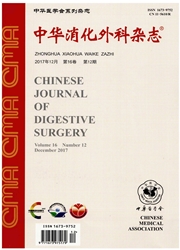

 中文摘要:
中文摘要:
目的探讨血管内介入技术建立肠系膜上静脉-门静脉血栓动物模型的可行性。方法小型猪9头,选用1头行预实验,8头用于正式实验。全麻下经皮经肝门静脉穿刺,用球囊导管阻塞门静脉主干并注入凝血酶或自体血栓,30min后行门静脉造影证实肠系膜上静脉-门静脉血栓形成,并比较血栓形成前后影像学变化。对术中死亡动物进行解剖,分析死亡原因,必要时取组织行病理学检查。结果9头猪均成功建立肠系膜上静脉-门静脉血栓模型。第1头预实验猪模型建立后10min死亡,病理证实死亡原因为DIC。正式实验8头猪,6头肠系膜上静脉-门静脉血栓形成后饲养14d,其余2头术后3h内死亡,死亡原因分别为肝破裂和麻醉药物过量。结论应用血管内介入技术可以建立肠系膜上静脉-门静脉血栓动物模型,为肠系膜上静脉-门静脉血栓的相关研究提供实验基础。
 英文摘要:
英文摘要:
Objective To assess the feasibility of interventional techniques in the establishment of animal model of superior mesenterie vein-portal vein (SMV-PV) thrombosis. Methods Nine miniature pigs were involved in the study including one for preliminary experiment. After general anesthesia, a balloon catheter was placed in the main trunk of PV to block the portal flow and then thrombin or autologous blood clot was injected to the SMV. Venography was performed to confirm the thrombosis 30 minutes later. Changes in the imaging before and after the thrombosis were observed. Pigs died during the experiment were anatomized to analyze the causes, and pathological examination was performed when necessary. Results The model of SMV-PV thrombosis was successfully established in all the pigs. One pig died of diffuse intravascular coagulation 10 minutes after model establishment in the preliminary experiment. Two pigs died of hepatorrhexis and over dose of anesthetics respectively 3 hours after model establishment, and the rest 6 pigs were fed for 14 days. Conclusion Interventional techniques are effective in the establishment of SMV-PV thrombosis model.
 同期刊论文项目
同期刊论文项目
 同项目期刊论文
同项目期刊论文
 Acute extensive portal and mesenteric venous thrombosis after splenectomy: Treated by interventional
Acute extensive portal and mesenteric venous thrombosis after splenectomy: Treated by interventional Interventional treatment for symptomatic acute-subacute portal and superior mesenteric vein thrombos
Interventional treatment for symptomatic acute-subacute portal and superior mesenteric vein thrombos 期刊信息
期刊信息
